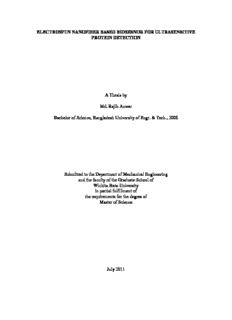Table Of ContentELECTROSPUN NANOFIBER BASED BIOSESNOR FOR ULTRASENSITIVE
PROTEIN DETECTION
A Thesis by
Md. Rajib Anwar
Bachelor of Science, Bangladesh University of Engr. & Tech., 2006
Submitted to the Department of Mechanical Engineering
and the faculty of the Graduate School of
Wichita State University
in partial fulfillment of
the requirements for the degree of
Master of Science
July 2011
© Copyright 2011 by Md. Rajib Anwar
All Rights Reserved
ELECTROSPUN NANOFIBER BASED BIOSESNOR FOR ULTRASENSITIVE
PROTEIN DETECTION
The following faculty members have examined the final copy of this thesis for form and content,
and recommend that it be accepted in partial fulfillment of the requirement for the degree of
Master of Science with a Major in Mechanical Engineering.
________________________________
Ramazan Asmatulu, Committee Chair
________________________________
Shalini Prasad, Committee Member
________________________________
Hamid Lankarani, Committee Member
iii
DEDICATION
To my family and friends
iv
ACKNOWLEDGEMENTS
I would like to thank my advisor, Dr. Ramazan Asmatulu for his continuous support and
encouragement throughout my Master‟s Degree. I would like to express my sincere gratitude to
my committee member and co-advisor, Dr. Shalini Prasad for her guidance and support in
conducting the experiments and completing the research.
My heartfelt appreciation goes to member of my thesis committee, Dr. Hamid Lankarani,
for his valuable comments and suggestions on this project. I am also very thankful to Dr. Krishna
K. Krishnan for giving me the chance to work with him in research project.
Special thanks go to Farhana Abedin for being such a loving wife, wonderful friend and a
very supportive colleague. She helped me in conducting all the experimental works and always
encouraged me in getting everything done at right time.
I would like to acknowledge Dr. Krishna Vatipalli for his help and co-operation in this
work. I would like to thank all my friends and family members for their support and
encouragement.
v
ABSTRACT
This research attempted to develop “label-free” biosensor for the detection of
cardiovascular risk biomarker, C-reactive protein (CRP). An electrospun Polystyrene (PS)/
Polyaniline (PANI) nanofiber was used as the sensing element of the biosensor and coupled with
electrical measurement system. High aspect ratio and porosity of nanoscale fiber provides size
matched confinement for tiny biomolecule immobilization, which leads to rapid transduction and
enhancement in signal strength. Nanofiber mat was integrated with a gold microelectrode
interdigitated chip and microfluidic chamber to create a lab-on-chip platform.
Results demonstrated that nanotextured fiber with appropriate chemical and electrical
functionality can be used as sensing element of an electrochemical biosensor for detection of
biomolecules at very low concentration. CRP was successfully detected at 100 fg/ml
concentration from human serum suggesting the potential of this lab-on-chip platform for early
detection of any cardiovascular risk. A large dynamic linear range of 100 fg/ml-1 μg/ml was
achieved in human serum for detection of CRP. Less than 10% cross-reactivity with human
albumin suggests the selective detection capability of the proposed biosensor.
vi
TABLE OF CONTENTS
Chapter Page
1. INTRODUCTION ...............................................................................................................1
1.1 Background .................................................................................................................1
1.2 Scientific Motivation ..................................................................................................4
1.3 Specific Project Goal ..................................................................................................6
2. REVIEW: ELECTROSPINNING AND BIOSENSOR ......................................................7
2.1 Electrospinning ...........................................................................................................7
2.2 Electrospinning Parameters ........................................................................................9
2.2.1 Solution Parameters .........................................................................................10
2.2.1.1 Viscosity/Concentration/Molecular Weight of Polymer ....................10
2.2.1.2 Surface Tension ..................................................................................11
2.2.1.3 Solution Conductivity .........................................................................11
2.2.1.4 Dielectric Constant of Solvent ............................................................11
2.2.2 Process Parameters...........................................................................................12
2.2.2.1 Voltage ................................................................................................12
2.2.2.2 Distance between Tip and Collector ...................................................12
2.2.2.3 Needle Diameter .................................................................................13
2.2.2.4 Type of Collector ................................................................................13
2.2.2.5 Flow Rate ............................................................................................14
2.2.3 Ambient Parameters .........................................................................................14
2.3 Fiber Morphology Optimization ...............................................................................14
2.4 Biosensors .................................................................................................................14
2.4.1 Working Principle ............................................................................................15
2.4.2 Label or label Free ...........................................................................................16
2.4.3 Biosensor Characteristics and Terminology ....................................................16
2.4.3.1 Sensitivity ...........................................................................................17
2.4.3.2 Selectivity ...........................................................................................17
2.4.3.3 Limit of Detection ...............................................................................17
2.4.3.4 Dynamic Range ...................................................................................17
2.4.3.5 Noise ...................................................................................................18
2.4.3.6 Drift .....................................................................................................18
2.4.3.7 Hysteresis ............................................................................................18
2.4.3.8 Warm-up Time ....................................................................................18
2.4.3.9 Response Time ....................................................................................18
2.5 Antibody-Antigen Interaction ...................................................................................18
2.6 Nanotechnology and Biosensors ...............................................................................19
2.7 Transduction Platforms .............................................................................................20
2.7.1 Optical Detection .............................................................................................21
2.7.2 Electrical/Electrochemical Detection ...............................................................22
vii
TABLE OF CONTENTS (continued)
Chapter Page
2.7.3 Mechanical Detection ......................................................................................23
2.8 Sensor Applications of Electrospun Nanofibers .......................................................24
2.9 Recent Biosensor Developments: Application to CRP Detection ............................25
2.9.1 Optical Sensors ................................................................................................25
2.9.2 Electrical/Electrochemical Sensors ..................................................................26
2.9.3 Mechanical Sensors .........................................................................................28
3. MATERIALS AND METHODS .......................................................................................31
3.1 Electrospinning Polymer Blend Fibers .....................................................................31
3.1.1 Polystyrene .......................................................................................................31
3.1.2 Polyaniline .......................................................................................................32
3.1.3 Doping Polyaniline ..........................................................................................34
3.1.4 Stock Solution Preparation and Electrospinning .............................................35
3.2 Sensor Platform .........................................................................................................37
3.2.1 Interdigitated Chip ...........................................................................................37
3.2.2 Manifold Preparation .......................................................................................37
3.3 Chip Integration for Experiment ...............................................................................39
3.4 Materials for Sensor Experiments .............................................................................39
3.4.1 C Reactive Protein ...........................................................................................40
3.4.2 Anti C-Reactive Protein ...................................................................................42
3.4.3 DSP Linker.......................................................................................................42
3.4.4 BSA Block .......................................................................................................43
3.4.5 Phosphate Buffer Saline ...................................................................................43
3.4.6 Human Serum ..................................................................................................43
3.5 Electrochemical Impedance Spectroscopy ...............................................................43
3.6 Experimental Protocol ..............................................................................................46
4. RESULTS AND DISCUSSION ........................................................................................48
4.1 Fiber Architecture .....................................................................................................48
4.2 Sensor Performance in Buffer Saline ........................................................................51
4.2.1 Sensitivity ........................................................................................................51
4.2.2 Selectivity ........................................................................................................52
4.3 Sensor Performance in Human Serum ......................................................................54
4.4 Discussion .................................................................................................................55
4.5 Limitations ................................................................................................................57
5. CONCLUSION AND FUTURE WORK ..........................................................................59
viii
TABLE OF CONTENTS (continued)
Chapter Page
REFERENCES ........................................................................................................................61
APPENDIX ........................................................................................................................68
ix
LIST OF TABLES
Table Page
1. Biosensor Formats Applied to CRP Detection ..................................................................30
2. Comparison of PS/PANI-HCSA Nanofiber Biosensor with ELISA and PS/PPY
Nanofiber Sensor ...............................................................................................................57
x
Description:Md. Rajib Anwar. Bachelor of Science, Bangladesh University of Engr. & Tech., 2006. Submitted to the Department of Mechanical Engineering and the

